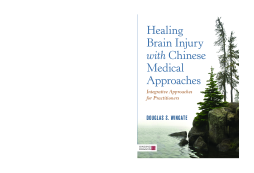
Additional Information
Book Details
Abstract
Learn to treat symptoms of traumatic and acquired brain injury using Chinese medicinal methods of acupuncture and herbal medicine. Covering both Western and Chinese medicine understandings of the brain, the book provides a thorough exploration of treatment options, including multiple acupuncture systems, Chinese herbal formulas, dietary and orthomolecular recommendations, and standard biomedical approaches.
Many symptoms associated with brain injury can be effectively addressed or reduced using TCM, including chronic headache, fatigue, dizziness, pain, and anxiety among others. The book highlights the special considerations that should be taken when working with people with brain injury, as well as when treating particular subpopulations, including pediatrics and veterans.
Douglas Wingate is an acupuncturist in private practice specializing in brain injury. He has presented at the Pacific NW Brain Injury Conference and been a board member and volunteered with multiple non-profits for brain injury. He lives in Oregon, USA.
This book provides a clinically-oriented and comprehensive transdisciplinary approach to the treatment of head injuries and their sequelae. Douglas Wingate skillfully opens Chinese medicine to a broader audience while maintaining its conceptual integrity and classical clinical wisdom. This work delivers a much-needed resource in facilitating person-centered collaborative care.
Mitchell Bebel Stargrove, ND, LAc, Author, Herb, Nutrient and Drug Interactions; Editor-in-chief, IBIS: Integrative BodyMind Information System
Table of Contents
| Section Title | Page | Action | Price |
|---|---|---|---|
| Healing Brain Injury with Chinese Medical Approaches by Douglas S. Wingate | 3 | ||
| Introduction | 9 | ||
| Chapter 1. The \"Silent Epidemic | 11 | ||
| Chapter 2. Standard Assessment and Diagnostics | 19 | ||
| Chapter 3. Treatment Mechanisms of Acupuncture | 31 | ||
| Chapter 4. The Brainstem and Cranial Nerves | 42 | ||
| Chapter 5. The Cerebellum | 51 | ||
| Chapter 6. Occipital Lobe | 59 | ||
| Chapter 7. The Limbic System | 67 | ||
| Chapter 8. The Parietal Lobes | 77 | ||
| Chapter 9. The Temporal Lobes | 88 | ||
| Chapter 10. The Frontal Lobes | 97 | ||
| Chapter 11. Nao: The Brain in Chinese Medicine | 106 | ||
| Chapter 12. Blood Stasis | 110 | ||
| Chapter 13. Mild Brain Injury/\nPost-Concussion Syndrome | 134 | ||
| Chapter 14. Treatment of Acute Brain Injury with Chinese Medicine | 142 | ||
| Chapter 15. Treatment of Chronic Brain Injury with Chinese Medicine | 145 | ||
| Chapter 16. Headache/Migraine | 152 | ||
| Chapter 17. Fatigue | 171 | ||
| Chapter 18. Dizziness | 179 | ||
| Chapter 19. Tinnitus | 187 | ||
| Chapter 20. Nausea and vomiting | 197 | ||
| Chapter 21. Dysphagia | 206 | ||
| Chapter 22. Seizures | 211 | ||
| Chapter 23. Chronic Pain | 228 | ||
| Chapter 24. Neuralgia and Numbness | 241 | ||
| Chapter 25. Paralysis/Muscular Atrophy | 250 | ||
| Chapter 26. Neuroendocrine Dysfunction | 257 | ||
| Chapter 27. Incontinence and Bowel Disorders | 270 | ||
| Chapter 28. Sexual dysfunction | 291 | ||
| Chapter 29. Visual Disturbances | 306 | ||
| Chapter 30. Sleep Disturbances | 334 | ||
| Chapter 31. Impaired Attention/Concentration | 359 | ||
| Chapter 32. Memory Impairment | 368 | ||
| Chapter 33. Executive Function | 377 | ||
| Chapter 34. Dementia | 382 | ||
| Chapter 35. Language and Communication Dysfunction | 390 | ||
| Chapter 36. Anxiousness | 397 | ||
| Chapter 37. Depressive Disorders | 406 | ||
| Chapter 38. Mania | 420 | ||
| Chapter 39. Bipolar Disorder | 426 | ||
| Chapter 40. Obsessive-Compulsive Disorder (OCD) | 437 | ||
| Chapter 41. Schizophrenia | 441 | ||
| Chapter 42. Hallucinations | 454 | ||
| Chapter 43. Post-Traumatic Stress Disorder (PTSD) | 459 | ||
| Chapter 44. Behavioral Changes and Emotional Lability | 471 | ||
| Chapter 45. Substance Abuse | 500 | ||
| Chapter 46. Special Considerations in Pediatric and Adolescent Brain Injuries | 508 | ||
| Chapter 47. Special Considerations in Military Populations | 519 | ||
| Chapter 48. Other Considerations of Brain Injury Care: Diet and Exercise | 526 | ||
| Appendix A: Point Indications Relating to the Brain According to George Soulié de Morant | 557 | ||
| Appendix B: Relevant Individual Herbs | 575 | ||
| Appendix C: Brodmann’s Areas of the Brain | 582 | ||
| Appendix D: Pharmaceuticals and Potential Herb–Drug Interactions | 584 | ||
| Bibliography | 611 | ||
| Subject Index | 612 | ||
| Author Index | 626 |
